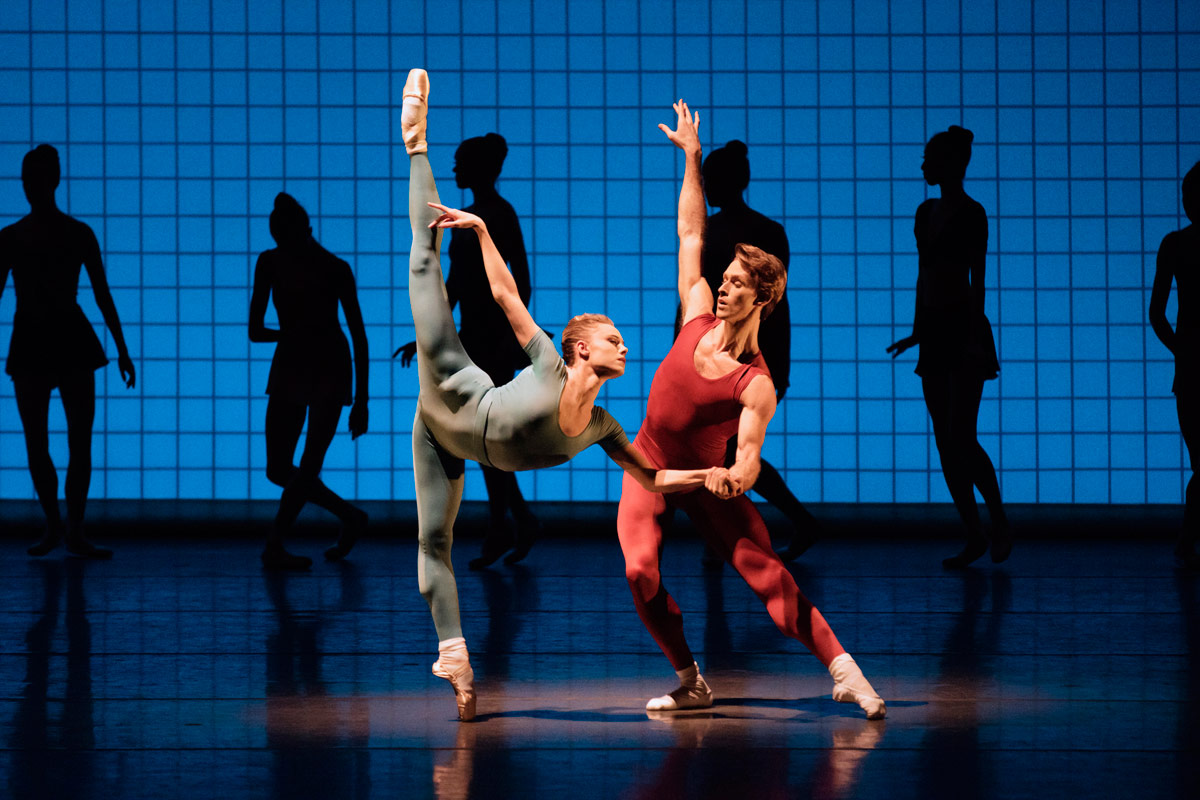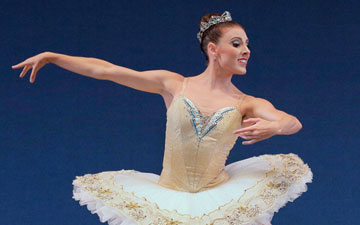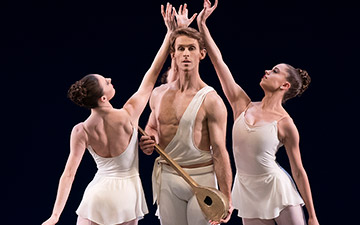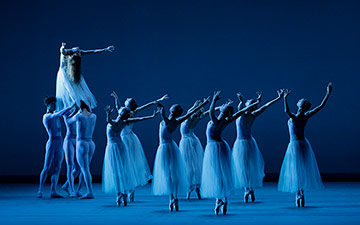
© Paul Kolnik. (Click image for larger version)
New York City Ballet
Jan. 20: Masters at Work – Liebeslieder Walzer, Glass Pieces
Jan. 21: All Balanchine I – Ballo della Regina, Kammermusik No. 2, Tchaikovsky Suite No. 3
★★★★✰ (20), ★★★✰✰ (21)
New York, David H. Koch Theater
20, 21 January 2015
www.nycballet.com
See the Music
The big news over at New York City Ballet is that the company has a new music director, Andrew Litton. Litton, who débuted with the company in 2014, conducted a few performances of Nutcracker in December (I missed them); his official coming out, however, took place on opening night, Jan. 19, when he conducted an all-American program with music by Leonard Bernstein, Samuel Barber, and George Gershwin (as orchestrated by Hershy Kay). The tempi were brisk, sometimes, as in the overture from Candide, perhaps too brisk, but Litton did manage to elicit a vibrant, lush sound from the players. The music had a newly-minted feel, which resulted, happily, in some very exciting performances onstage, particularly in Fancy Free and Who Cares? Keep an eye out for Harrison Coll, folks. The corps dancer was electric without being over-eager in the Gershwin: syncopated, sharp, and beaming.
The following night, Jan. 20, consisted of a double-header, with Balanchine’s Liebeslieder Walzer filling the first half and Jerome Robbins’ Glass Pieces following after the break. The temperature in Glass Pieces was uncharacteristically low. Under the baton of Clotilde Otranto, the orchestra sounded muffled and a tad lethargic as it cycled through Philip Glass’s arpeggiated, mesmeric patterns. (Especially noticeable after the more lively performance the night before.) The dancing, too, felt a little rote, lacking that nervous edge that can give this piece, a kind of paean to New York traffic patterns and the cool postmodernism of the eighties, such a buzz. The most striking element, the bobbing heads of the figures in silhouette along the back of the stage, was as effective as ever. Watching them file by, they began to look like clones or ballerina-shaped cyborgs.
Liebeslieder, Balanchine’s evocative 1960 ballet set at a fin-de-siècle house party where couples waltz and live out private dramas – while a quartet sings Brahms lieder and two pianists play four hands – included a series of débuts. Rebecca Krohn and Russell Janzen, both newcomers to the ballet, were convincing as a pair of lovers in the tremulous, vulnerable phase of a love affair. Their relationship was almost voluptuous; as he whispered secrets into her ear, her body seemed to melt in response; in a later pas de deux, one could almost feel the caress of a kiss as their faces came together. All this was made more vivid by the contrast in their demeanors, Krohn placid, Janzen ardent, bewildered, almost feverish.

© Paul Kolnik. (Click image for larger version)
In another début, Lauren Lovette inflected her role with a note of sorrow, as if trying to shake off a lingering sadness. In the first section of the ballet, performed in heeled shoes and long dresses, she danced a haunted pas de deux in which her partner (the always attentive and gentle Jared Angle), pushed her lightly forward again and again as if willing her to go on; each time, she lunged, low to the ground, then wandered off, until he tapped her shoulder and brought her back from her reverie. She is a convincing actress; one can almost read her thoughts. Such details are essential in a ballet like Liesbeslieder, where the steps are like a fine shell containing the characters’ inner lives. Similarly, Tiler Peck, dancing with Amar Ramasar (also débuting) used her pliant back to convey a sense of resignation; there’s a whiff of Anna Karenina to her interpretation. With every viewing of Liebeslieder, new mysteries emerge.
After seven years, Ballo della Regina returned to the repertory on the evening of Jan. 21. It seems to have lost some of its snap in the intervening years. Litton’s interpretation had verve, but lacked melodic sweep; the music is by Verdi, after all, from the opera Don Carlos. In its original function as a divertissement in the middle of the opera, the ballet had a plot of sorts, about a fisherman searching the seas for a perfect pearl. Balanchine did away with the story, keeping only a buoyant, underwater feeling and a ceremonious, courtly ending. The ballerina role, danced here by Megan Fairchild, is a killer, full of hops, snappy pas de bourrés, and turning jumps, all on pointe, all at breakneck speed. The man’s part is just as loaded with complications. Joaquin de Luz pulled it off with polish, but little more. Fairchild’s footwork lacked crispness, and with it, the wit that makes this ballet sparkle. Of the four female soloists, Ashley Laracey was notable for the lyricism and expansiveness of her upper body and Ashly Isaacs for the driving power of her leaps across the stage.
Balanchine’s Kammermusik No. 2, which followed, is a relentless work; the whole ballet, with the exception of a gooey pas de deux, feels like an endless, high-energy introduction, with little respite. The two principal women – Teresa Reichlen and Sara Mearns – jog and twist and skip and bend like two hopped-up cheerleaders, their ponytails swishing all the while. (Apparently one of the original cast-members likened the ballet’s busy-busy feeling to the inner workings of a computer, and one can easily see what she meant.) The most curious thing about this 1970 ballet is the fact that the corps consists solely of men. Their steps seem to poke fun at the stylized ensemble movements in ballets like Rubies and Agon; they point their fingers and stomp around on their heels or form complex cat’s cradles, carefully stepping over arms and legs in order to reconfigure themselves in ever-ingenious patterns. It’s a funny ballet in which no-one seems to pay anyone else any attention.

© Paul Kolnik. (Click image for larger version)
The evening ended with Tchaikovsky Suite No. 3. Abi Stafford, back from maternity leave, looked more relaxed and free than I’ve seen her in a long time in the “Valse Mélancholique”. Georgina Pazoguin was a blur of windswept tulle in the “Scherzo.” And then, finally, the finale: “Theme and Variations,” danced by Tiler Peck and Andrew Veyette. Peck, completely in her element, seemed to expand and contract with the music, luxuriating in the movement with an ease and control that leave one almost breathless. She holds a pose a moment longer, creating a dramatic rubato with her limbs, almost stopping time, then launches into the next phrase with renewed, almost teasing attack. She extends her lines by tilting her neck just so, creating a swan-like curve from the top of her head and down through her torso. She’s a wonder.
As exciting as it is to watch her, though, at times she seems cut off from everyone else onstage, dancing in her own, luxuriant bubble. So it was tonight. Veyette, whose own dancing was rather rough, didn’t help matters by looking down, as if willing himself to get through the ballet. Tonight, Tiler Peck’s true partner, the only one that really mattered, was Tchaikovsky’s music, and it was almost enough.

















You must be logged in to post a comment.